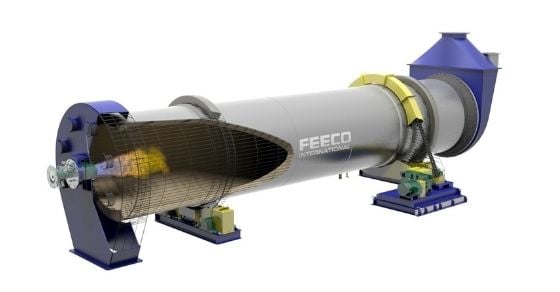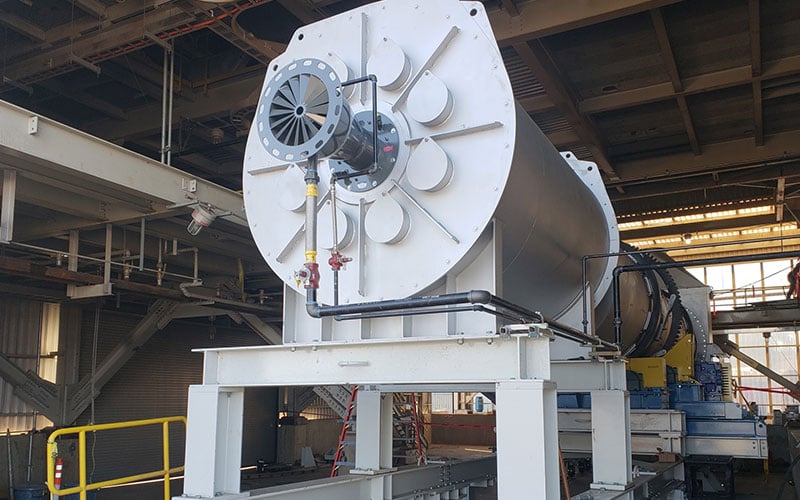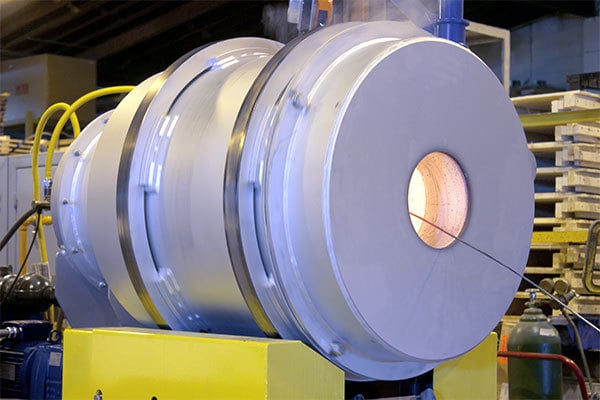The rotary kiln plays a pivotal role in the production of roofing granules by curing the coloring or coating onto granules and forming a durable bond between the two. Part of the effectiveness of the rotary kiln in this setting, however, relies on the ability to properly control kiln temperature and residence time through engineered kiln design.
The following covers why temperature control and proper kiln design is so important in the production of roofing granules, as well as basic kiln design parameters, and tips for acquiring the best kiln for the job.
Why Rotary Kiln Temperature Control is so Essential
The roofing granule production process requires precision at every step in order to consistently produce granules to the desired specification.
Following the coating (coloring) drum, granules must not be over- or under-heated, as this would put the integrity of the coating at risk in terms of color consistency and performance expectations.
Consistency in Color
Roofing granule production lines must be able to consistently produce the precise color grades the company offers; colors must be uniform from one production run to another.
Further, the color-staying power must also be met; colors must be durable and stable, capable of withstanding handling, application onto the asphalt, and constant exposure to the elements without premature fading.
Meeting Performance Expectations
Proper curing of the coating or coloring onto granules is also critical to the performance of the product; in addition to meeting color specifications, granules must also be able to protect the asphalt shingle from harmful UV rays and subsequent premature breakdown. Further, granules are expected to perform increasingly more complex tasks. In some cases, the coating may serve other critical functions, such as discouraging algae growth or reflecting light to keep the roof from absorbing heat.
As such, roofing granule producers must be able to rely on their rotary kiln in order to properly solidify the bond between coating and granule, and this requires expert kiln design.
Designing a Rotary Kiln for Roofing Granules
In addition to reliability, a heavy-duty build, and high throughput, roofing granule kiln manufacturers must take several additional measures to ensure their kilns can reliably produce product to spec without risking product integrity or equipment longevity. The basic design parameters of a roofing granule kiln are outlined here.
Direct-Fired Configuration
The direct-fired configuration, in which the granules and hot gases including products of combustion are in direct contact with each other, should be used because it offers the most efficient design for processing roofing granules, with the greatest level of heat transfer between material and heating medium.

This 3D Rotary Kiln illustrates the direct-fired configuration, in which the material and combustion gases are in direct contact
Combustion Chamber
A combustion chamber can be included in the design of roofing granule kilns, but is not required.
A combustion chamber is often added to kilns to house the combustion reaction and prevent contact between the material being processed and the combustion flame. This prevents product breakdown and maintains product integrity.
If a combustion chamber is not used in the design, protective flights/lifters can be employed to prevent contact with the flame. This reduces the overall cost and footprint of the unit without sacrificing product quality.

FEECO Combustion Chamber with burner
Protective Flights (Lifters)
Protective flights (lifters) are no different in structural design than other material lifters, but instead are positioned strategically to keep material away from the flame when a combustion chamber is not used. This combines the high efficiency of direct-fired processing without putting product quality at risk.
Stainless Steel Drum
The rotary drum itself should be constructed of stainless steel for heat resistance. While more costly than carbon steel, the use of stainless steel ensures that the drum shell will be able to withstand the high temperatures without the use of a refractory layer, which would add additional cost to the unit, incur more maintenance requirements, and prohibit the use of flights.
Tips for Acquiring the Best Roofing Granule Kiln
While there is a significant amount of guidance that could be provided around designing a rotary kiln suited to the task of processing roofing granules, it can all be distilled down into two overarching themes: testing the process and working with an expert.
Test the Rotary Kiln Process
One fail-safe way to ensure the acquired kiln will meet production needs is to start the design process with a testing program. This is particularly important as new color compounds and coatings are developed to meet changing market needs; testing not only confirms feasibility of the intended process, but it also provides the data necessary for the design of a commercial-scale unit.

Direct batch kiln used for testing in the FEECO Innovation Center
The FEECO Innovation Center offers decades of expertise combined with batch- and pilot-scale kilns for feasibility testing and process development work. In addition to kiln testing, the Innovation Center also offers testing for coating/coloring, pre-heating, and drying roofing granules as well.
Facilities like these offer the opportunity to significantly de-risk the path to equipment design and commercial-scale production.
Work With a rotary kiln Expert
Avoiding over- or under-heating of granules during the curing process can be challenging and means a one-size-fits-all approach to kiln design is inadequate for the requirements of the roofing granule industry. To ensure a suitable kiln is selected, carefully vet and select the rotary kiln manufacturer.
Process expertise, data-backed design, and a proven track record go a long way in acquiring a system that will reliably yield consistent results for years to come.
Conclusion
Achieving the right temperature control during the curing process is essential to consistently meeting product color, quality, and performance expectations in roofing granules. Through the use of design customizations, rotary kilns can be engineered to produce consistent results efficiently time and again. To confirm process conditions and de-risk the path to commercial-scale production, FEECO recommends testing the process at batch and pilot scale, as well as working with an expert.
Through decades of expertise, and equipment with a well-earned reputation for reliability, FEECO has become the roofing granule industry’s preferred provider for rotary kilns, coating/coloring drums, rotary dryers, and coolers, as well as process development services and parts and service support. For more information on how we can help your roofing granule production line, contact us today!



